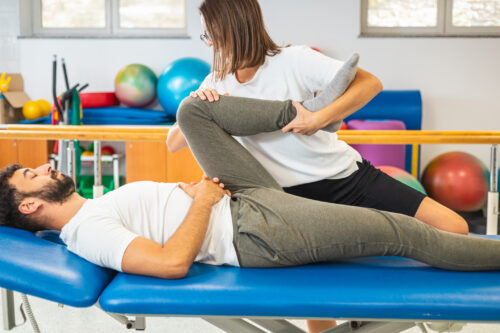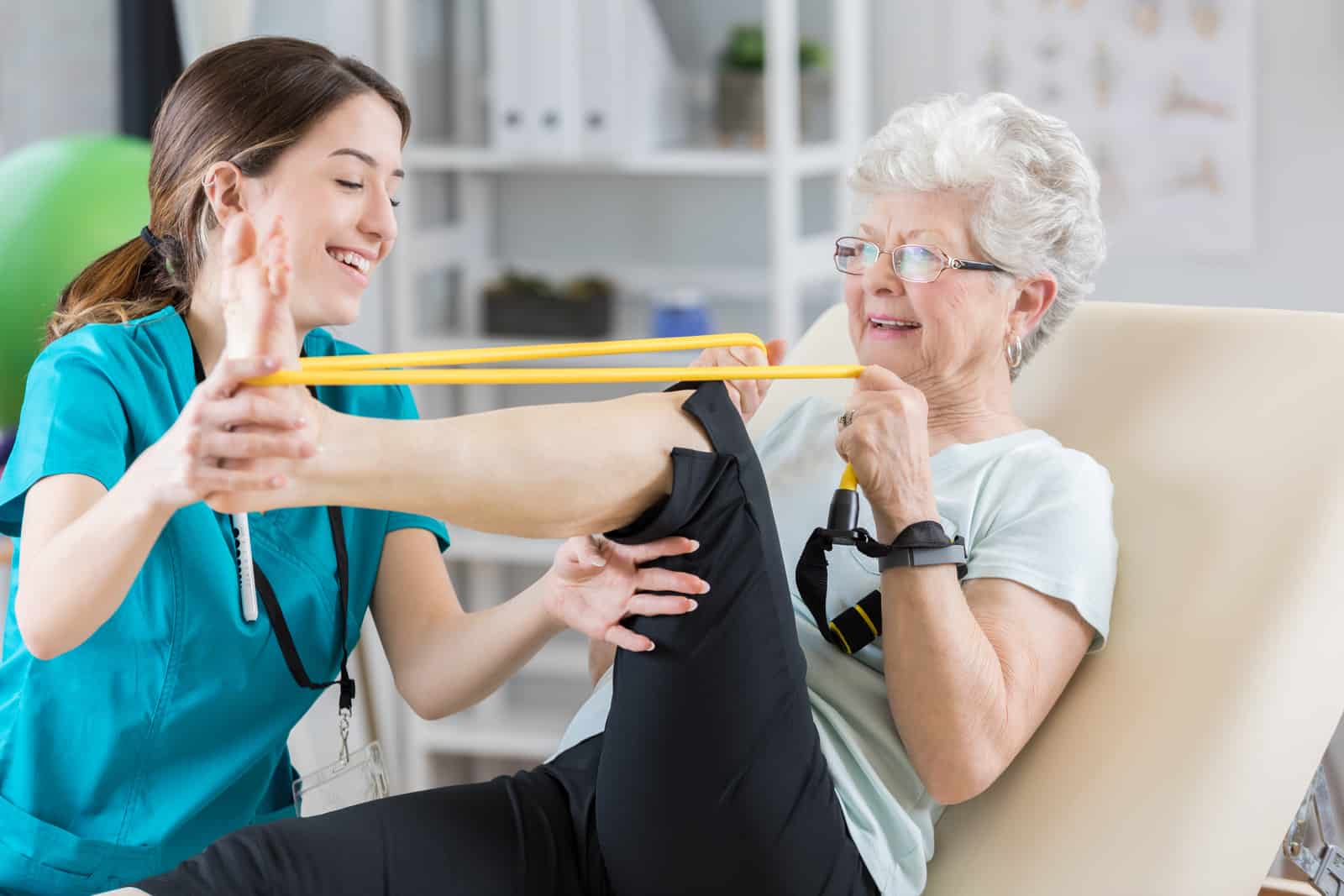Hip and knee injuries are a common sight for physical therapists. The CDC states that nearly half of all Americans develop knee arthritis, and a quarter develop hip arthritis by the time they reach age 85. On top of that, many other injuries and conditions plague people’s knees and hips. This article will discuss common injuries, physical therapy for hip and knee assessment methods, and effective rehabilitation strategies.
Recommended course: An Overview of Hip and Knee Rehabilitation for the Physical Therapist, Updated
Physical therapy assessment for hips and knees
Physical therapists should always assess both knees and hips even when the injury is in only one joint. This is to determine if one is influencing issues in the other, as they share a close biomechanical relationship, muscles, and innervation.
Subjective assessment
A thorough assessment requires a deep understanding of the injury from the patient’s perspective. Questions include:
- Signs and symptoms: When does the patient feel pain? What movements/activities feel good/bad? Is there swelling?
- Past medical history: Previous injuries in the same spot? Underlying medical conditions?
- Activities: Patient’s occupation? Are they an athlete? Do they participate in sports/exercise? What are their activity levels?
- Red flags: Night sweats? Sudden change in appetite? Unexplained weight loss?
Functional movement assessments
Assess functional movements, including:
- Gait: From the sagittal and frontal plane
- Squat: Observe body alignment, difficulty, and reliance of upper extremities
- Single-leg stance: Assess duration
- Heel raises: Note symmetry of muscle tone and balance
- Visual inspection: Observe pelvic position, knee alignment, swelling, and muscle symmetry
Range of motion and strength testing
Evaluate both passive and active range of motion, including hip and knee:
- Flexion/extension
- Abduction/adduction
- Internal/external rotation
Manually test the strength of appropriate muscles, noting pain and effort of exertion. Grade each muscle for intervention guidance and future baseline comparison.
Special tests
Examine reflexes, sensation, and motor function to identify any nerve-related issues. Rehab professionals should also conduct special testing as appropriate, such as:
- The Stork test
- FABER
- Thomas test
- Posterior Shear test
- Lachman’s test
- Anterior/posterior drawer test
- McMurray’s test
- Apley’s Grind test
Physical therapy interventions for hip pathologies
The following discusses common hip pathologies and their rehabilitation strategies.
Physical therapy for hip osteoarthritis
Hip osteoarthritis (OA) is the progressive degeneration of the hip joint cartilage, resulting in pain, stiffness, and reduced function. A combination of rehabilitative strategies will likely be used due to the complexity of hip OA, focusing on:
- Pain management: Utilize ice, heat, TENS, manual therapy, and exercise (such as isometrics).
- Patient education: Educate on pain management, activity modification, exercise routines, and rehab goals to ensure plan adherence and a positive outlook.
- Exercise: Progressively strengthen surrounding musculature, build balance, and improve functional mobility.
Total Hip Arthroplasty (THA)
THA is a surgical procedure that replaces a damaged hip joint with an artificial one. Rehabilitation should focus on:
- Early mobilization: Passive and active range of motion exercises early post-surgery to prevent stiffness. Weight-bearing as tolerated may enhance joint loading and stimulate healing.
- Gait retraining: Normalize gait. Treadmill training with partial body weight support improves walking confidence and symmetrical gait post-THA.
- Strengthening: Muscle strengthening around the hip (e.g. glutes) is paramount to optimal recovery.
Gluteus medius tendinopathy
Gluteus medius tendinopathy is an overuse injury characterized by pain and dysfunction in the gluteus medius tendon which may lead to calcification in the tendon.
Eccentric strengthening should be done first, then concentric. Exercises should be performed bilaterally to avoid contralateral injury. They should also include core strengthening to improve hip and pelvis stability.
Femoral acetabular impingement (FAI) and acetabular labrum lesions
FAI involves abnormal contact between the femoral head and acetabulum and can lead to osteoarthritis and lesions. Treatment may include:
- Activity modifications
- Manual therapy
- Stabilization exercises
- Surgery (if conservative treatment fails)
Ischemic necrosis of the femoral head
Ischemic necrosis is the death of bone tissue due to a lack of blood supply, affecting the femoral head to cause pain, limited range of motion, and functional impairment.
Early intervention includes lifestyle changes (including education on alcohol consumption), range of motion exercises, and joint rest, while advanced stages require surgical solutions.
Septic arthritis
Septic arthritis is an infection in the joint space, causing inflammation and damage. Treatment should include gentle mobilizations after physical signs of joint synovitis are gone, and then aggressive range of motion and hip strengthening after medical clearance.
Physical therapy for hip fractures
There are several types of hip fractures, and treatment may change between types.
However, physical therapists should progressively challenge the patient with weight-bearing, modify activities of daily living, and create a return-to-sport/work plan that focuses on improving strength, balance, and stability.
Common childhood hip disorders and treatment
Common pediatric hip disorders and their typical treatments include:
- Developmental hip dysplasia and dislocation: Gentle movement/stretching, hip strengthening, range of motion exercises, and gait retraining.
- Legg-Calve-Perthes Disease: Balance, lower extremity strengthening/range of motion exercises, and gait training.
- Slipped capital femoral epiphysis (SCFE): Hip strengthening, aerobic conditioning, and gait/balance training post-surgery.
- Juvenile rheumatoid arthritis: Physical therapy should address pain, range of motion restrictions, and educate the child and family in joint protection.
Physical therapy interventions for knee pathologies
There are many knee pathologies, and their interventions differ. Rehab professionals should prioritize individualized care.
Knee osteoarthritis
Knee osteoarthritis is a progressive joint disorder where the knee’s cartilage breaks down, resulting in pain, stiffness, and reduced joint flexibility. A multimodal approach should be taken for treatment, including:
- Strengthening: A progressive exercise plan including for the hip and ankle if appropriate.
- Manual therapy: Combined with exercise, manual therapy should be tailored to the unique needs and goals of each patient.
- Patient education: Educate how to modify activities, manage pain, and improve functional movement.
Total Knee Arthroplasty (TKA)
A TKA is when a knee joint is replaced with an artificial one. Early mobilization is key to avoiding stiffness and increased pain in the future, and a progressive plan of weight-bearing, strengthening, and stretching exercises should be implemented.
Normalizing gait patterns and improving functional movement should be the priority.
Soft-tissue injuries of the knee
This may include muscle strains and contusions. Rehabilitation includes a gradual increase in weight-bearing, improving muscular strength, increasing range of motion, and normalizing functional movements (e.g. through squats, lunges, etc.).
Ligament injuries
Ligament injuries include:
- ACL tears
- PCL tears
- MCL/LCL tears
- Ligament strains
Physical therapy interventions for ligament injuries address range of motion, swelling, and recovery from surgery (if surgery happened). Strategies range from:
- Supporting ligaments: With braces as appropriate, depending on type and severity of injury.
- Immobilization: Temporarily, usually in accordance with the surgeon.
- Exercise: A progressive program depends on the injury and severity. It should include exercises aimed at improving stability, strength, balance, and range of motion.
- Gait: Retraining normal gait patterns.
- Neuromuscular control: Return to normal control of muscles and coordination.
Meniscal tears
Meniscal tears involve damage to the fibrocartilage in the knee joint causing pain, unstableness, and limited range of motion. Rehabilitation should include progressive quadriceps and hamstring strengthening, with a gradual progression to weight-bearing activities as tolerated.
Physical therapy for the knee varies widely depending on the type of tear, severity, and whether there is surgical intervention. Each patient needs to be treated uniquely.
Articular cartilage injury
Damage to articular knee cartilage can lead to many complications, and physical therapy interventions need to match the patient’s level of damage and disability.
Interventions may include:
- Manual therapy: To improve osteokinematic and arthrokinematic motion of the tibiofemoral joint.
- Conditioning: To improve tolerance to activity.
- Strengthening: Improve stability, decrease load on the affected joint, and promote healing.
Fractures affecting the knee joint
These may involve breaks in the femur, tibia, or patella, and require an individualized approach. Depending on the injury, a rehabilitation plan could involve initial immobilization, gentle range of motion exercises, progressive strengthening, and progressive weight-bearing.
Physical therapy is especially important to restore functional mobility after the fracture has healed.
Patellofemoral disorders
Physical therapists should focus their assessments on understanding what the underlying causes of patellofemoral disorders are. This will guide treatment, which can include a multimodal approach depending on the type of disorder.
Common treatment includes strengthening the muscles in surrounding joints, especially the hips.
Physical therapy for hip and knee
Physical therapists should closely assess each patient to find the root cause of hip and knee injuries to guide treatment. Rehabilitation can vary greatly between patients, and an individualized program is required.
Promoting optimal outcomes, understanding patient needs, and refining clinical skills will greatly contribute to a positive rehabilitation journey for patients with knee and hip injuries.





